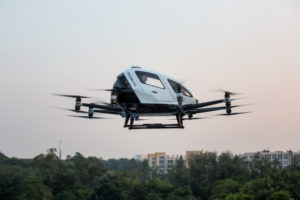
Courtesy of EHang
Researchers seek to improve battery power to enable urban air mobility flights.
by Jim Magill
The key to achieving a future of urban air mobility (UAM) lies in the development of a power source, compact enough to not take up too much room or add too much weight to an aircraft, yet powerful enough to deliver the energy needed to power vertical takeoffs and landings, and sustained flight capabilities.
The Federal Aviation Administration defines UAM as “a safe and efficient aviation transportation system that will use highly automated aircraft that will operate and transport passengers or cargo at lower altitudes within urban and suburban areas.” NASA envisions UAM to include small drones, electric aircraft and automated air traffic management.
While researchers have been making great progress in developing batteries to power everything from passenger cars to segments of the electric grid, employing batteries to power aircraft capable of carrying people has remained a major challenge.
An ad hoc group of experts in the field of energy storage, representing U.S. government agencies and private industry groups has been working for more than a year and a half to look into creating the next generation of batteries and other innovative fuel sources to power the aerial vehicles needed to achieve UAM, as well as those larger aircraft used in commercial aviation.
According to the group’s recent report, prepared through a collaboration of the U.S. Department of Energy and NASA, electric vertical take-off and landing (eVTOL) and short-range consumer aircraft are the two segments of aviation most likely to benefit from the development of next-generation batteries in the near future. This aviation industry segment is expected to profit from the current research and development and commercial deployment of batteries being used to power electric vehicle (EVs).
Within the next five to 10 years, eVTOL aircraft will be enabling urban air mobility, “providing intracity passenger, cargo and emergency services operated by electric-powered aircraft, either remotely piloted or under autonomous control,” the study states. It estimates that the market for urban air mobility could grow to $9 billion by 2030 and $80 billion by 2041.
“As we look forward, batteries are going to be incredibly important at decarbonizing every part of our economy,” study author and DOE energy storage expert Venkat Srinivasan said in an interview.
“We have to think deeply about decarbonizing the aviation sector,” said Srinivasan, director of the Argonne Collaborative Center for Energy Storage Science (ACCESS) and deputy director of the Joint Center for Energy Storage Research (JCESR). “Urban air mobility is the first application we looked at.”
With energy densities of approximately 150-to-170 watt hours per kilogram when combined in a pack, today’s lithium-ion batteries could power initial demonstration flights and are close to having enough energy density to enable near-term eVTOL flights of nine- to 20–passenger aerial vehicles with a limited range capability, the study found.
The researchers found that batteries needed to power the kind of unmanned eVTOL vehicles needed to achieve urban air mobility would need to have an energy density that is just 10% to 15% higher than the current generation of lithium-ion batteries used in electric vehicles. Given the current state of research, such a step change in energy density should prove to be relatively easy to achieve, Srinivasan said. The bigger challenge comes from developing more powerful batteries capable of handling the challenges of VTOL flight.
“When you take off you need a lot of power and when you land you need a lot of power, because you’re defying gravity” he said. Normally a user would employ a fully charged battery at takeoff, but would want to have that battery be nearly depleted by the end of a flight so that he or she could properly recharge it.
“But for an eVTOL application, you absolutely have to have the power when you land,” Srinivasan said.
The researchers studied the potential for developing new battery chemistries that could overcome the limitations of the types of lithium-ion batteries currently being used in electric vehicles. At the first meeting of the public-private partnership, held in December 2019, participants “examined the feasibility of very high-energy-density primary batteries (such as lithium-sulfuryl-chloride or lithium-metal-fluoride) with the aim of establishing their ability to be recharged” the report states.
Members of the group also discussed the possible use in aviation applications of lithium-oxygen and lithium-sulfur batteries, which currently are being studied for use in EVs, “assuming fundamental limitations could be solved.”
In addition to studying improvements to current battery technology, participants in the group also are looking into alternative sources of power for the aviation sector, such as fuel-cell technology in which “the fuel can either be electrochemically or chemically reserved using hydrogen, ammonia or other synthetic molecules,” the report states.
“How far can we push batteries? There’s going to be a limit. That means we’re not going to be doing batteries for some of these applications,” Srinivasan said.
“As a battery person. I want to push the battery as far as we can, but there’s going to be a point at we can no longer compete with hydrolyzed resources,” he said.
Want to read more about urban air mobility? Check out what FAA Chief Administrator Steve Dickson says, investment in UAM vehicles, UAM infrastructure, and the first aerial sightseeing operations. Need more information on battery and engine technologies for drones? See more about charging technologies here and here, and hybrid hydrogen engines for passenger drones here.
 Jim Magill is a Houston-based writer with almost a quarter-century of experience covering technical and economic developments in the oil and gas industry. After retiring in December 2019 as a senior editor with S&P Global Platts, Jim began writing about emerging technologies, such as artificial intelligence, robots and drones, and the ways in which they’re contributing to our society. In addition to DroneLife, Jim is a contributor to Forbes.com and his work has appeared in the Houston Chronicle, U.S. News & World Report, and Unmanned Systems, a publication of the Association for Unmanned Vehicle Systems International.
Jim Magill is a Houston-based writer with almost a quarter-century of experience covering technical and economic developments in the oil and gas industry. After retiring in December 2019 as a senior editor with S&P Global Platts, Jim began writing about emerging technologies, such as artificial intelligence, robots and drones, and the ways in which they’re contributing to our society. In addition to DroneLife, Jim is a contributor to Forbes.com and his work has appeared in the Houston Chronicle, U.S. News & World Report, and Unmanned Systems, a publication of the Association for Unmanned Vehicle Systems International.
Miriam McNabb is the Editor-in-Chief of DRONELIFE and CEO of JobForDrones, a professional drone services marketplace, and a fascinated observer of the emerging drone industry and the regulatory environment for drones. Miriam has penned over 3,000 articles focused on the commercial drone space and is an international speaker and recognized figure in the industry. Miriam has a degree from the University of Chicago and over 20 years of experience in high tech sales and marketing for new technologies.
For drone industry consulting or writing, Email Miriam.
TWITTER:@spaldingbarker
Subscribe to DroneLife here.
https://dronelife.com/2021/10/07/can-batteries-power-urban-air-mobility-flights/
 Unmanned Aerial Vehicle The latest drone news
Unmanned Aerial Vehicle The latest drone news


